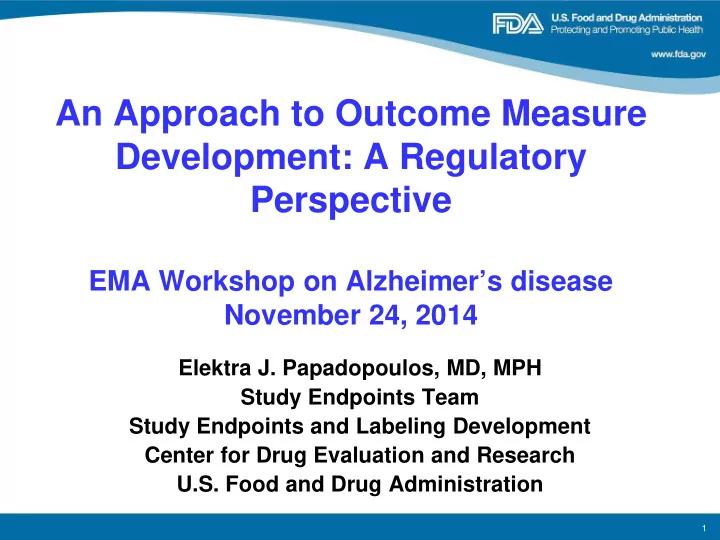

An Approach to Outcome Measure Development: A Regulatory Perspective EMA Workshop on Alzheimer’s disease November 24, 2014 Elektra J. Papadopoulos, MD, MPH Study Endpoints Team Study Endpoints and Labeling Development Center for Drug Evaluation and Research U.S. Food and Drug Administration 1
Disclosure The views expressed in this presentation are those of the speaker, and do not necessarily represent an official FDA position. 2
Treatment Benefit • Demonstrated by evidence that the treatment has a positive impact on a concept (outcome) of interest: – How long a patient lives – How a patient feels or functions in daily life • Can be demonstrated as either: – A comparative advantage in how patients survive, feel or function – A comparative reduction in treatment-related toxicity 3
Purpose of Outcome Assessment • To determine whether or not a drug has been demonstrated to provide treatment benefit • A conclusion of treatment benefit is described in labeling in terms of the outcome targeted for measurement i.e., the concept of interest 4
Types of Outcome Assessments • Survival • Clinical outcome assessments (COAs) – Patient reported outcomes (PROs) – Clinician-reported outcomes (ClinROs) – Observer reported outcomes (ObsROs) – Performance outcomes (PerfOs) • Biomarkers – A physiologic, pathologic, or anatomic characteristic that is objectively measured and evaluated as an indicator of some normal or abnormal biologic function, process or response to a therapeutic intervention 5
Evidence of Treatment Benefit • Direct evidence of treatment benefit: – Derived from endpoints that actually measure survival or aspects of how patients feel and function in daily life • Indirect evidence of treatment benefit: – Derived from endpoints that measure outcomes (concepts) that are related to (but do not actually measure) the meaningful aspects of how patients survive, feel or function 6
Direct Verses Indirect Evidence of Treatment Benefit Survival Blood Pressure Pain 6MWT PSA Breathlessness Indirect Direct Evidence Evidence Evidence Continuum 7
When is a COA adequate for use? • Drug application review (IND/NDA/BLA) – Substantial evidence of treatment benefit includes requirement for well-defined and reliable assessments (21CFR 314.126) – Empiric evidence that demonstrates that the score quantifies the concept of interest (i.e., the outcome) in the targeted context of use so that the data can be interpreted and appropriately conveyed in labeling 8
Good Measurement Principles • Defines good measurement principles to consider for “well-defined and reliable” (21 CFR 314.126) PRO measures intended to http://www.fda.gov/downlo provide evidence of ads/Drugs/GuidanceComplia treatment benefit nceRegulatoryInformation/G • All COAs can benefit from uidances/UCM205269.pdf the good measurement principles described within the guidance 9 9
Well-defined and Reliable • The tool adequately measures the concept of interest in the context or clinical setting of interest • To assess this, we review the tool’s measurement properties: – Content validity – Construct validity – Reliability (particularly test-retest) – Ability to detect change 10
Review of ClinRO, ObsRO, PRO, and PerfO Measures: Any Differences? SAME: DIFFERENT: I. Instrument II. Targeted Claims III. Endpoint Model IV. Conceptual Framework V. Content Validity VI. Other Measurement Properties VII. Interpretation of Scores VIII. Language Translation and Cultural Adaptation IX. Data Collection Method X. Modifications XI. Clinical Trial Design and Data Analysis Issues XII. Key References 11
Seeking Advice from FDA • Discuss plans early! • 2 pathways: – In the context of an Investigational New Drug (IND) program – Drug Development Tool (DDT) Qualification 12
Drug Development Tool Qualification Guidance (Final January 2014) • Describe a process NOT evidentiary standards • Qualification process described for http://www.fda.gov/downloads/ Biomarkers, Animal Drugs/GuidanceComplicanceReg Models, and Clinical ulatoryInformationi/Guidances/ UCM230597.pdf Outcome Assessments (COA) 13
Qualification of COAs • COA qualification is a conclusion that within the stated context of use, the results of measurement can be relied upon to represent a specific concept (i.e., outcome) with a specific interpretation when used in drug development and regulatory decision-making • Plain language: Within a specific clinical context, we’re measuring the right thing, in the right way, and we can rely upon the results of the qualified assessment across clinical trials within that clinical context 14
Roadmap to Patient-Focused Outcome Measurement in Clinical Trials • Intended to illustrate how one might embark upon a sound, orderly, instrument selection or development pathway that is in alignment with the objectives of the drug development program and the clinical trial context of use 15
16
www.diahome.org 17
Conclusions • The roadmap to well-defined and reliable outcome assessment begins with an understanding of the disease or condition • Outcome assessment development relies upon a well-defined context of use and targeted concept (outcome) • The qualification process allows for the development of publicly available COAs for use in multiple drug development programs over time 18
Where to find more information • Clinical Outcome Assessment Qualification Program Webpage: http://www.fda.gov/Drugs/DevelopmentApprovalProcess/ DrugDevelopmentToolsQualificationProgram/ucm28407 7.htm 19
Recommend
More recommend